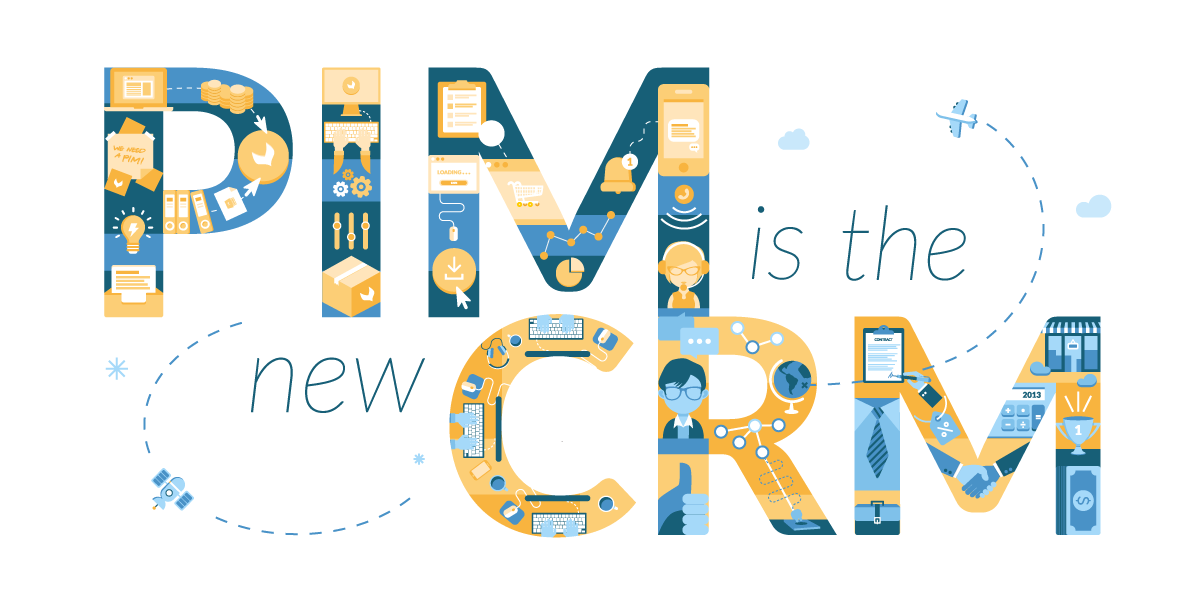We’ve been hearing this a lot at partner meetups, retailer conferences, from our customers, and even echoing down the hallways of our own offices.
What do people mean by “PIM is the new CRM”?
It’s about momentum.
PIM is the hot tool in the ecommerce space. How hot? Reports estimate that the overall product information management (PIM) category will grow at compound annual growth rate of 25.3% to an astonishing $15.8 Billion dollars by 2021. This is amazing growth for a product category that barely existed five years ago!
Around 2005, Oracle’s “Siebel” was a worldwide leader in the CRM market but was limited to larger companies. Now, PIM is growing at the same explosive speed that CRM did when Salesforce changed the game. Salesforce was able to generalize and democratize the CRM market in 2010’s, which then allowed small and medium sized companies to access and utilize this kind of service. They made their service accessible to these companies with their famous “no software” punchline and a structure that relied on full cloud-based technology.

Salesforce was able to drive CRM from a glorified Rolodex to the bedrock of customer information around which companies built their B2B sales and support organizations. In the process, their revenue grew from $175 million in 2005 to $6.67 billion in fiscal year 2016.
PIM has the same momentum behind it today as CRM did ten years ago.
It’s about transformation.
Cloud-based CRM was the right tool that emerged at the right time. It offered a collaborative solution right when B2B sales shifted decisively to team collaboration and customization. CRM effectively allowed companies to put customers at the center of their organization.

Similarly, PIM is growing so energetically because it is the key enabler for a major retail and brand mega–trend: global omni-channel operations that provide highly customized and local experiences for every customer.
PIM lets you to cost-effectively customize and personalize product descriptions to suit each segment of your client base (e.g. separate sizing for children, women, and men), push customized product ranges & descriptions depending on the selling channel, and exponentially increase conversion rates and overall sales… all while reducing returns thanks to a much more qualitative information.
In other words, PIM drives your team’s workflow and collaboration around your products and thereby puts your products and customers at the center of your company.
PIM provides the platform your teams need to enable a scalable collaborative data enrichment workflow.
It’s about robust platforms.
CRM didn’t start out as “one database to rule them all”. It grew organically. Companies needed to centralize their client data and improve data quality to provide a seamless experience for both prospects and customers. To do that, sales and customer support began to gather and share client knowledge from the field and build a client data enrichment workflow. From there, it was natural to connect other internal data sources such as ERP, accounting, compliance, and other critical systems. Suddenly… CRM was the center of most companies’ data universe.
PIM is starting to serve that same kind of foundational function for customers that have used PIM for more than a couple years. The more systems that are hooked into PIM, such as your ERP, supplier databases, and other product information sources on one side… and eCommerce, mobile, printed, and point of sale systems on the other… the more valuable the PIM becomes.
And it’s not just overall utility, PIM can also serve marketplaces and internal services like “contact centers”, “CRM”, or business intelligence engines as a unique source of truth for all of your product data.
It’s about thriving ecosystems.
Salesforce and other CRM systems started gaining even more utility as both technology and implementation partners flocked to the new platform. They were able to build additional functionality such as importation and sync tools, email marketing, digital contracts, chat systems, and more through plugins and application marketplaces. This allowed Salesforce, in particular, to quickly cover every critical interface and functionality needed—far faster than if Salesforce had tried to keep all of this development in-house.

But, Salesforce didn’t just recruit developers. They also encouraged and created a huge partner system of consultants to implement and customize Salesforce. The result is a breathtakingly huge partner ecosystem that includes broad and deep integrations and functionality. The value that this ecosystem drives is huge, as evidenced by the whopping 171,000 people that attended Dreamforce in 2016!
TIGO team and our partners provide not just technology but also business systems support through catalog structure consulting, product enrichment workflow design, and the publishing process development.
That is why we are rapidly recruiting both developers of new integrations and plug-ins as well as a robust community of integrators and implementers to customize the PIM experience for each company. We already have thousands of community members and hundreds of enterprise deployments. And while we haven’t yet broken the hundred thousand mark for attendance at our partner conference, we did have 27 companies from 7 different countries represented at our second partner summit.
It’s about ROI.
At the end of the day, both CRM and PIM systems provide significant return on investment as they enable companies to transform the limitations of their processes and rapidly scale their businesses.
PIM enhances the overall customer experience while making it economical to provide high-quality product information for more products across more channels and more locations.
Henry Pham







